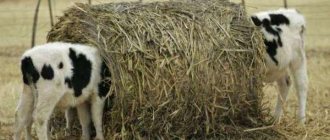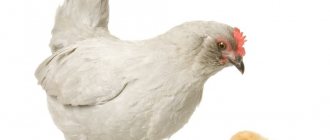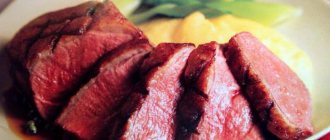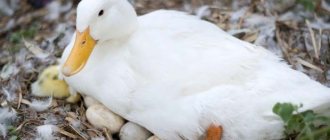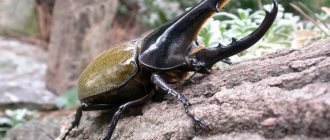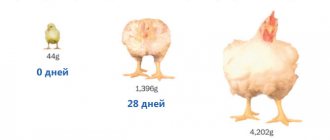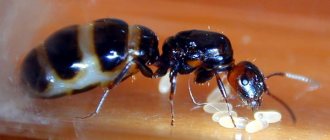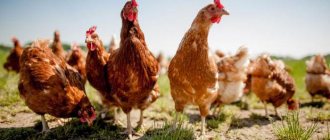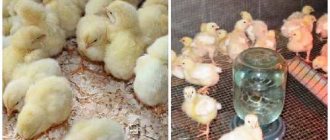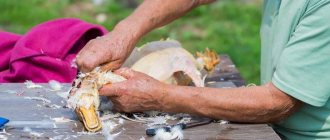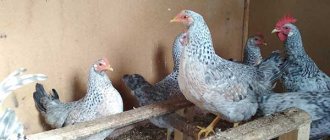Mularda ducks have become extremely popular throughout the world in recent decades. These birds are equally convenient for growing on a private farm and in a large enterprise, and in terms of productivity and quality of meat they have practically no rivals among modern varieties of domestic ducks.
Mulardy ducks (pictured) are unpretentious and well adapted to various living conditions
Domestic homestead owners are happy to take such pets for themselves. Today we decided to introduce readers in detail to “mulards”, their economic characteristics and specific content.
Description
Growing mulards brings good profits. They were obtained in France as a result of crossing Indo ducks and Peking ducks (Orpington or Allier can be used instead of the latter). The resulting hybrid gained popularity due to its rapid weight gain and high quality meat. The only negative is sterility. A hybrid breed does not produce offspring at home.
According to reviews, growing mulards is not difficult. Ducks are unpretentious and do not create noise in the poultry yard. They are clean, calm, can do without bodies of water, and do not strive for freedom.
The main color of ducks is white; there is always a black spot on the head. The presence of black feathers on the wings and tail is allowed. The bird's body is tightly knit and elongated. The tail is small and well developed. The neck is long, the head is oval, medium in size. The beak is elongated, flat, light in color. The eyes are dark. The legs are short and yellow. The wings are long. They are pressed tightly to the body.
Performance
Mulards stand out from other bird breeds due to their rapid weight gain. So, at the age of two months their weight reaches almost four kilograms. Moreover, such a mass is typical not only for males; females are only 0.5 kg inferior in performance.
Special diets and husbandry methods make it possible to produce drakes weighing up to 6 kg within 90 days. To do this, they are raised in cramped cages where there is no way to stand on their feet. Most of the feed is corn. But such metrics will require a significant investment of time and resources.
Mulard's liver - the famous foie gras
In addition to delicious dietary meat, about which there are so many reviews, mulards are valued for their liver. In France, they are grown to produce tasty, fatty liver for the delicacy foie gras.
Previously, geese were used for this purpose, but this breed of duck requires less time to obtain results.
As mentioned above, Mulard ducks are not capable of breeding, so they are not suitable for raising for eggs. To be fair, it is worth noting that at times drakes cover ducks, sometimes they even lay eggs, but they are not fertilized.
Productivity
Raising ducks of this breed pays off. In just 2-3 months they gain weight of 3.5-4 kg. Four-month-old individuals weigh 5-6 kg, depending on the quality of fattening. Due to their large dimensions, mulards are popularly called “ducks and geese”. Unlike other ducks, their meat is low in fat - the fat layer accounts for 3%. It does not have a specific taste. Females are not much smaller than males - the difference is about 500 g. An additional advantage of the hybrid is tasty liver. With proper fattening, its weight reaches 500-550 g. Ducks begin to lay eggs at the age of 180-210 days, and produce up to 220 eggs per year.
It is recommended to slaughter birds before molting occurs, which usually occurs on the seventieth day of life. When changing plumage, ducks lose weight, feather stumps remain on the body, which affects the quality of the carcasses. If the deadline is missed, you need to wait about a month.
You can speed up the slaughter period by raising ducks in cages - by the age of one and a half months they gain sufficient weight for this. The main disadvantage of this content is that the meat becomes fatty.
Owner reviews
Anna, 66 years old, Astrakhan region
We have been growing “mulardiks” for several years in a row. We buy daily allowances from the poultry farm. This is easier than specially keeping “parents” – “musks” and “Peking”. There is a small problem with babies: feeding cannot be left to chance until the third day, they simply do not know how to feed themselves. You have to keep an eye on it, and some people have to push food directly into it. And then they start bursting so hard that just come on. Last year we tried to switch to a mixture of chicken and pork feed after 3 weeks. They ate and grew right before our eyes. We score starting from 3 months. It is unprofitable to keep it any longer; the growth rate drops sharply. The carcasses are approximately 3 kg (without heads, legs and giblets), clean, the breasts are very meaty. The meat is tasty, tender, lean. Good ducks, almost problem-free.
Ivan, 47 years old, Tver
These are typical broiler hybrids. If you don’t bother with your own breeding, everything is not difficult. Young animals are more expensive than ducklings of other breeds, but it is still profitable to buy. I calculated with all expenses (for the last two years). On average, a kilogram of carcass cost 180 rubles. Considering the quality of the meat, it’s very good. Plus, some specimens (for some reason not all) produce large and tasty liver. It probably depends on the qualities of the parents; You need to order ducklings from reliable breeders. In general, the bird is not capricious, grows quickly, and does not get sick. Quite suitable for stocking up on meat for a family. I will buy more.
Natalya, 52 years old, Bashkortostan
Excellent ducks to raise both for yourself and for sale. I am raising my chicks. Every year I keep 3-4 families (musk drakes, Peking females). There are some small problems with hybrids, but it’s not difficult to get used to. I don’t consider their gluttony to be a drawback; at such a growth rate, this is normal. And with the diets everything is simple: grass, crushed potatoes, boiled potatoes, and ready-made additives. But they like to pinch each other - that’s a problem. I have been giving sulfur since I was a week old, but it doesn’t always help. Sometimes the only thing that saves is jigging and keeping the “ringleaders” separately. Otherwise everything is fine. There is a lot of meat, the taste is excellent. The bird is calm: it does not run away, it behaves relatively quietly. Maintenance is not burdensome. I advise everyone, if you don’t hatch your own ducklings, then take them from the factory.
Breeding at home
To raise mulards at home, they purchase hatching eggs or ducklings - when breeding within the herd, it will not be possible to obtain offspring due to the sterility of the individuals. You can independently breed productive hybrids by crossing:
- drake musk duck and female Peking breed;
- male Pekingese breed and Indian ducks.
In any of the options, the family consists of one breeder and three to six females.
When forming a family, it is worth considering that Pekin ducks rarely hatch their offspring, while Indian ducks become excellent hens.
For mating, sexually mature females and strong males who have reached the age of at least 9-10 months are selected. The best period for dividing into families is mid-spring. The birds will need some time to adapt.
Each family is allocated a separate pen - at least 1 square meter per individual. m. Prepare nests (one for 3 females) and install them in a shaded, quiet place. The diameter of the bottom is about 40 cm. A layer of straw is placed inside and the litter is kept clean.
From the moment egg laying begins, eggs are collected regularly and a dummy is left in the nest. If this is not done, the duck may look for another place to lay. Specimens suitable for incubation are stored in a cool room. Optimal temperature for maintaining productive qualities: +12°C. Humidity – 70%. The choice for incubation is carried out according to the following criteria:
- smooth shell without sagging;
- correct form;
- average weight (about 80 g);
- no cracks or heavy contamination.
The eggs are turned daily to prevent the yolk from moving. Before laying, they are stored for no longer than ten days, after which the hatchability percentage drops.
Before being placed in an incubator or in a brood nest, eggs are checked for internal defects using an ovoscope. There should be no microcracks, displacement of the air sac, double or displaced yolk, or foreign inclusions.
Organization of the place
A spacious enclosure is suitable for raising mulards, as well as Indian ducks. Its area corresponds to the proportion of one m² per three birds. Set aside a place in the poultry house for a pond - they don’t need a lot of water, but bathing is required. Also provide a place for ducks to walk.
Provide the bird enclosure with a ventilation and heating system. The optimal temperature for ducks is on average 20-22 degrees, near heat sources: 25-30 degrees.
Place a bedding of sawdust, hay, or dry grass on the floor. Thickness is about 15 cm. The material is easy to purchase in specialized stores or on farms.
Since the feet of mulard ducks are almost always wet with water, it is recommended to remove the contaminated layer of bedding. Otherwise, harmful insects and parasites will appear on the surface, which will harm the health and life of the birds.
Avoid drafts, but ventilate the house regularly.
Such care is the key to active weight gain of ducks, their health and the success of your business.
Hatching chicks
At home, mulard ducks are raised by placing eggs under the hen or placing them in an incubator.
Breeding in the nest
If a duck sits on a clutch, it can hatch 15-20 eggs, depending on its size (all eggs must be covered). The yield percentage is high - on average, no more than two eggs are lost from a clutch (minimum yield - 80%). The hen is provided with water and food.
Incubation
When using an incubator, the hatching percentage is lower - about 65%. Before laying eggs, the shells are disinfected with a pink solution of potassium permanganate. Optimal liquid temperature: +30°C. They are kept in the solution for 3 minutes, after which they are laid out on a clean cloth. If there are stains, carefully rub them off with a soft toothbrush, sponge or cloth.
Before being placed in the incubator, the eggs are transferred from a cool room to a warm one so that they warm up to room temperature. Each specimen is marked on opposite sides to control overturning. When laying horizontally, the rotation is performed 180 degrees, when laying vertically - 45. Incubation takes 31 days. Recommended settings:
| Duration (days) | Humidity (%) | Temperature (°C) | Cooling | Turn |
| 1-3 | 75 | +37.6 | – | 4-6 |
| 4-7 | 75 | +37.4 | – | 4-6 |
| 8-16 | 62 | +37.4 | – | 4-6 |
| 17 | 62 | +37.3 | – | 4-6 |
| 18-21 | 55 | +37.3 | 2 times a day for 15-20 minutes | 4-6 |
| 22-24 | 50 | +37.2 | 2 times a day for 15-20 minutes | 4-6 |
| 25-28 | 50 | +37.1 | 2 times a day for 15-20 minutes | 4-6 |
| 29 | 67 | +37 | – | – |
| 30 | 75 increasing to 85 | +36.8 | – | – |
| 31 | 85 | +36.7 | – | – |
As the eggs cool, sprinkle them with water. During the incubation process, the clutch is checked three times using an ovoscope to reject unfertilized specimens and those where death or disruption of embryo development is observed. Approximate dates: seventh, sixteenth and twenty-fifth days.
From the moment of pecking, hatching takes about a day. The dried young animals are transferred to a brooder. At the first stage, the bottom is covered with paper and changed regularly.
How to care for hatched chicks
Breeding mulards, which have excellent reviews, will be successful, of course, only if the technology for caring for young animals is followed. After hatching, the ducklings are usually left in the incubator until dry. They are then transferred to a box. Since dampness is contraindicated for small chicks, a lattice bottom is first installed in it.
For a large number of ducklings, it is advisable to use a brooder instead of a box. The frame of this device can be assembled from timber, and the casing can be made from plywood and polycarbonate. You must place a special heating lamp for the brooder inside. You can buy it, for example, at a pet store. The lamp should be hung in such a way that the ducklings do not get burned, and there is at least one shaded corner inside the brooder.
Heating in the box is arranged in the same way. Only in this case a regular incandescent lamp is used. Of course, feeders and drinkers should be placed in the box or brooder.
Raising and feeding ducklings
Small Mulard ducks are kept in a brooder for the first three weeks, after which they are transferred to floor housing. The room should be warm and draft-free. The floor is covered with hay or straw. Peat and sawdust are contraindicated because chicks mistake them for food.
Temperature and lighting
At the first stage, stocking density: up to 16 heads per 1 sq. m. The temperature under the heater is gradually adjusted:
- up to a week of age it is maintained at +28…+30°C;
- by two weeks of age, it is gradually, day by day, reduced to +23°C;
- three-week-old chicks are kept at +20°C (heating is not required in summer).
Air humidity – 65-70%. Drafts are contraindicated, but air ventilation is required. The place where ducklings are kept is constantly cleared of debris and equipment is washed. From the age of two weeks, the chicks begin to be released for walks in good weather - the temperature should not be lower than +20°C. At one month of age, young animals can be placed in a common poultry house, but in a pen separate from the adults.
Up to a week of age, the duration of illumination is 20 hours, intensity is 2-4 W/sq.m. During rest periods, the light is not turned off completely, but the brightness is reduced to 1-2 W/sq.m. From the second week, the duration of illumination is reduced weekly by 60 minutes, ultimately bringing it to sixteen hours.
Feeding the young
Ready-made mixed feed or self-prepared mash is suitable for feeding young animals. When preparing the latter, a mixture of boiled eggs and corn, wheat or oatmeal is used. If the chicks are not interested in food, then you can sprinkle a little on their backs - the moving food attracts attention and the ducklings begin to peck at it.
On the third day, add chopped grass (alfalfa, clover, nettle), sour milk, cottage cheese. Gradually the diet is expanded, they begin to give vegetables, meal, bone meal, feed yeast, duckweed, bran, and legumes. From the tenth day, the egg is removed and gravel is poured into separate containers. Mandatory feed components:
- chalk - from 0.1 to 0.5 g, the rate is gradually increased until three weeks of age;
- shell, ground shell - from 0.5 to 3 g, depending on age.
Birds are given dry and wet food - the mash has a crumbly consistency and cannot be stored for longer than an hour. Drinkers should always be filled with water. The frequency of feedings is reduced gradually - at first, ducklings are fed every 2 hours, by the age of one month, 3 feedings are left.
Features of behavior
According to all farmers without exception, this hybrid is completely problem-free. Although mulard ducks (reviews from owners of homestead farms allow us to judge them as one of the calmest breeds) can fly a little, they do not need to be clipped with their wings, like musk ducks. The weight of this bird is significant. And therefore, in any case, she will not be able to fly over the fence.
Mulards are usually kept using the floor method. These ducks are not left on homestead farms for the winter. They are not capable of producing offspring, and it is not advisable to keep them for fattening for more than three months.
Fattening Mulard ducks
When raised for meat, it is better to use complete feed for waterfowl - they contain all the necessary components.
When independently preparing a feed mixture for one-month-old young animals, the following is added to its composition:
- crushed grain (corn, wheat, barley) – 80-100 g;
- grain waste – 30-40 g;
- wheat bran – 35-40 g;
- meal and cake – 15-20 g;
- yeast – 1 g;
- shell – 5-6 g;
- bone meal – 2-3 g;
- salt – 1 g;
- gravel – 2 g.
Add to the wet mixture:
- boiled potatoes and other vegetables (60-80 g);
- grass – 70-80 g;
- meat and fish waste – 20-25 g.
While walking, birds receive additional nutrition - they eat duckweed, grass, and insects.
When raising mulard ducks on the liver, they are limited in movement and force-fed through a funnel. At home, corn becomes the main component of nutrition - it gives the product an appetizing color and ensures rapid weight gain.
When can you cut?
Up to 3 months All nutrition goes towards building muscle mass, so the fat ratio will be minimal. At the age of 70 days, mulards molt, so slaughter should be carried out at 2 or 3 months.
Features of the face
Before slaughter, poultry should be prepared in advance. This will help simplify subsequent processing of the carcass.
Main stages of preparation:
- put the mulards on a starvation diet 10-12 hours before the procedure;
- place the birds in a separate room and leave the lighting on, which will help to empty the intestines.
In the morning you can start slaughtering.
Sequence of actions when performing the procedure:
- Tie the paws and hang them upside down.
- Press the wings to the back.
- Pull back the neck and cut the carotid artery, while holding the knife at an angle to the neck.
- Leave the carcass hanging for 15 minutes.
- After the time has passed, remove, cut and remove the giblets.
